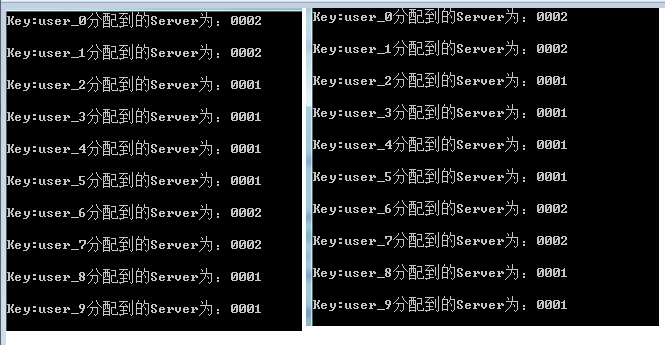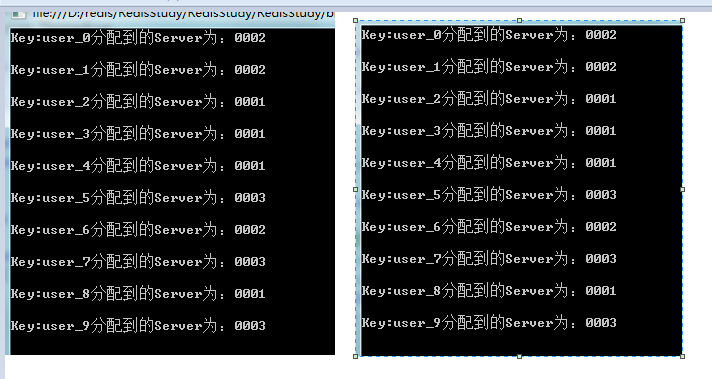由于redis是单点,但是项目中不可避免的会使用多台Redis缓存服务器,那么怎么把缓存的Key均匀的映射到多台Redis服务器上,且随着缓存服务器的增加或减少时做到最小化的减少缓存Key的命中率呢?这样就需要我们自己实现分布式。
Memcached对大家应该不陌生,通过把Key映射到Memcached Server上,实现快速读取。我们可以动态对其节点增加,并未影响之前已经映射到内存的Key与memcached Server之间的关系,这就是因为使用了一致性哈希。
因为Memcached的哈希策略是在其客户端实现的,因此不同的客户端实现也有区别,以Spymemcache、Xmemcache为例,都是使用了KETAMA作为其实现。
因此,我们也可以使用一致性hash算法来解决Redis分布式这个问题。在介绍一致性hash算法之前,先介绍一下我之前想的一个方法,怎么把Key均匀的映射到多台Redis Server上。
由于LZ水平有限且对Redis研究的不深,文中有写的不对的地方请指正。
方案一
该方案是前几天想的一个方法,主要思路是通过对缓存Key中的字母和数字的ascii码值求sum,该sum值对Redis Server总数取余得到的数字即为该Key映射到的Redis Server,该方法有一个很大的缺陷就是当Redis Server增加或减少时,基本上所有的Key都映射不到对应的的Redis Server了。代码如下:
/// <summary> /// 根据缓存的Key映射对应的Server /// </summary> /// <param name="Key"></param> /// <returns></returns> public static RedisClient GetRedisClientByKey(string Key) { List<RedisClientInfo> RedisClientList = new List<RedisClientInfo>(); RedisClientList.Add(new RedisClientInfo() { Num = 0, IPPort = "127.0.0.1:6379" }); RedisClientList.Add(new RedisClientInfo() { Num = 1, IPPort = "127.0.0.1:9001" }); char[] charKey = Key.ToCharArray(); //记录Key中的所有字母与数字的ascii码和 int KeyNum = 0; //记录余数 int Num = 0; foreach (var c in charKey) { if ((c >= 'a' && 'z' >= c) || (c >= 'A' && 'Z' >= c)) { System.Text.ASCIIEncoding asciiEncoding = new System.Text.ASCIIEncoding(); KeyNum = KeyNum + (int)asciiEncoding.GetBytes(c.ToString())[0]; } if (c >= '1' && '9' >= c) { KeyNum += Convert.ToInt32(c.ToString()); } } Num = KeyNum % RedisClientList.Count; return new RedisClient(RedisClientList.Where(it => it.Num == Num).First().IPPort); } //Redis客户端信息 public class RedisClientInfo { //Redis Server编号 public int Num { get; set; } //Redis Server IP地址和端口号 public string IPPort { get; set; } }
方案二
1、分布式实现
通过key做一致性哈希,实现key对应redis结点的分布。
一致性哈希的实现:
- hash值计算:通过支持MD5与MurmurHash两种计算方式,默认是采用MurmurHash,高效的hash计算。
- 一致性的实现:通过java的TreeMap来模拟环状结构,实现均匀分布
什么也不多说了,直接上代码吧,LZ也是只知道点皮毛,代码中还有一些看不懂的地方,留着以后慢慢琢磨
public class KetamaNodeLocator { //原文中的JAVA类TreeMap实现了Comparator方法,这里我图省事,直接用了net下的SortedList,其中Comparer接口方法) private SortedList<long, string> ketamaNodes = new SortedList<long, string>(); private HashAlgorithm hashAlg; private int numReps = 160; //此处参数与JAVA版中有区别,因为使用的静态方法,所以不再传递HashAlgorithm alg参数 public KetamaNodeLocator(List<string> nodes/*,int nodeCopies*/) { ketamaNodes = new SortedList<long, string>(); //numReps = nodeCopies; //对所有节点,生成nCopies个虚拟结点 foreach (string node in nodes) { //每四个虚拟结点为一组 for (int i = 0; i < numReps / 4; i++) { //getKeyForNode方法为这组虚拟结点得到惟一名称 byte[] digest = HashAlgorithm.computeMd5(node + i); /** Md5是一个16字节长度的数组,将16字节的数组每四个字节一组,分别对应一个虚拟结点,这就是为什么上面把虚拟结点四个划分一组的原因*/ for (int h = 0; h < 4; h++) { long m = HashAlgorithm.hash(digest, h); ketamaNodes[m] = node; } } } } public string GetPrimary(string k) { byte[] digest = HashAlgorithm.computeMd5(k); string rv = GetNodeForKey(HashAlgorithm.hash(digest, 0)); return rv; } string GetNodeForKey(long hash) { string rv; long key = hash; //如果找到这个节点,直接取节点,返回 if (!ketamaNodes.ContainsKey(key)) { //得到大于当前key的那个子Map,然后从中取出第一个key,就是大于且离它最近的那个key 说明详见: http://www.javaeye.com/topic/684087 var tailMap = from coll in ketamaNodes where coll.Key > hash select new { coll.Key }; if (tailMap == null || tailMap.Count() == 0) key = ketamaNodes.FirstOrDefault().Key; else key = tailMap.FirstOrDefault().Key; } rv = ketamaNodes[key]; return rv; } } public class HashAlgorithm { public static long hash(byte[] digest, int nTime) { long rv = ((long)(digest[3 + nTime * 4] & 0xFF) << 24) | ((long)(digest[2 + nTime * 4] & 0xFF) << 16) | ((long)(digest[1 + nTime * 4] & 0xFF) << 8) | ((long)digest[0 + nTime * 4] & 0xFF); return rv & 0xffffffffL; /* Truncate to 32-bits */ } /** * Get the md5 of the given key. */ public static byte[] computeMd5(string k) { MD5 md5 = new MD5CryptoServiceProvider(); byte[] keyBytes = md5.ComputeHash(Encoding.UTF8.GetBytes(k)); md5.Clear(); //md5.update(keyBytes); //return md5.digest(); return keyBytes; } }
2、分布式测试
1、假设有两个server:0001和0002,循环调用10次看看Key值能不能均匀的映射到server上,代码如下:
static void Main(string[] args) { //假设的server List<string> nodes = new List<string>() { "0001","0002" }; KetamaNodeLocator k = new KetamaNodeLocator(nodes); string str = ""; for (int i = 0; i < 10; i++) { string Key="user_" + i; str += string.Format("Key:{0}分配到的Server为:{1} ", Key, k.GetPrimary(Key)); } Console.WriteLine(str); Console.ReadLine(); }
程序运行两次的结果如下,发现Key基本上均匀的分配到Server节点上了。

2、我们在添加一个0003的server节点,代码如下:
static void Main(string[] args) { //假设的server List<string> nodes = new List<string>() { "0001","0002" ,"0003"}; KetamaNodeLocator k = new KetamaNodeLocator(nodes); string str = ""; for (int i = 0; i < 10; i++) { string Key="user_" + i; str += string.Format("Key:{0}分配到的Server为:{1} ", Key, k.GetPrimary(Key)); } Console.WriteLine(str); Console.ReadLine(); }
程序运行两次的结果如下:

对比第一次的运行结果发现只有user_5,user_7,user_9的缓存丢失,其他的缓存还可以命中。
3、我们去掉server 0002,运行两次的结果如下:

对比第二次和本次运行结果发现 user_0,user_1,user_6 缓存丢失。
结论
通过一致性hash算法可以很好的解决Redis分布式的问题,且当Redis server增加或减少的时候,之前存储的缓存命中率还是比较高的。
关于Redis的其他文章
http://www.cnblogs.com/lc-chenlong/p/4194150.html
http://www.cnblogs.com/lc-chenlong/p/4195033.html
http://www.cnblogs.com/lc-chenlong/p/3218157.html